Huawei Mate 40 Pro review: an excellent flagship
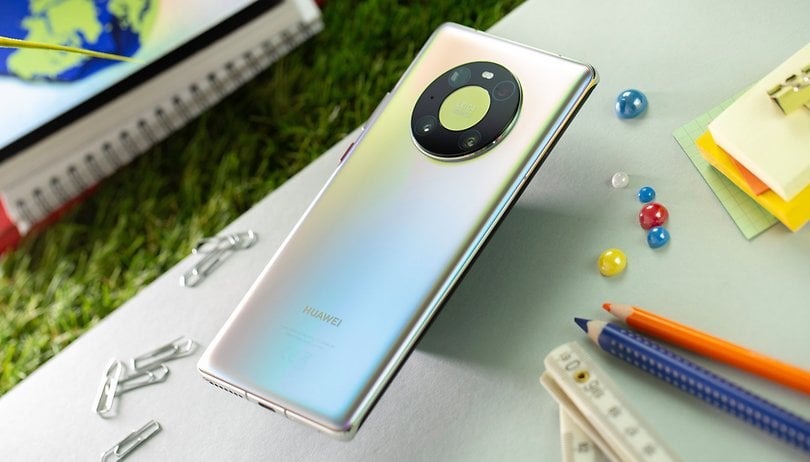

Check and checkmate? No! The Huawei Mate 40 Pro has, more than ever compared to its predecessors such as the Huawei P40, the heavy burden of ensuring the tech press and its cohorts continue the narrative that the Chinese tech giant's smartphones are not fit for use outside of China without Google. After reviewing it for close to a month for NextPit, I can unequivocally state that this is not the case at all. Far from it.
Good
- Very nice OLED display with 90 Hz refresh rate
- Fantastic design
- Best camera modules on the market
- Solid battery life
- 65 W fast charge support
- Wireless and reverse charging
- Kirin 9000 chipset
- Big improvements on EMUI 11
- IP68 rating
Bad
- Does not feel complete without Google services
- Expensive considering Europe does not carry the basic model
- Missing the 3.5 mm audio jack
- Throttling hinders performance to manage overheating

Who is the Huawei Mate 40 Pro for?
The Huawei Mate 40 Pro has been available in France since Thursday, October 22nd with the asking price of £1,099.99. Sad to say that this is now the "classic" price of a flagship device when it comes to the 'Pro' version. This is not an unjustified price tag in the absolute sense, considering how other manufacturers also follow this route, but it is true that the manufacturer could have or should have made an effort to lower the price point after taking into consideration that there is only one model being offered in Europe without the cheaper lower specifications version.
There are certain quarters that consider the Mate 40 Pro to be Huawei's swansong, which is the final flagship smartphone before it reaches the end of the road, and also a grand closing statement. The very idea of that might sound appealing to some, but I do not share the opinion of some of my colleagues in the industry, who most of them happen to be European (and yes, Americans do not care much about it since Huawei smartphones are no longer sold in the U.S. anyway).
But if we put aside the fears of some and the fantasies of others, we can safely say that the Huawei Mate 40 Pro marks the end of an era but not the end of Huawei - at least for Huawei in Europe.
The latest Kirin SoC, touted to be the most powerful on the market according to the benchmarks available at its release, (which happened prior to the launch of the Apple A14 Bionic chip in the iPhone 12 series) happens to be standing on its own in the smartphone world as the Chinese tech giant has been let down by nearly all of its suppliers, resulting in the shutting down its home-grown chip production.
The camera module in the Huawei Mate 40 Pro is very similar to the P40 Pro, which once again promises a very high-end photo experience that is hard to match among its Android or Apple competitors.
Last but not least, the hard work done on EMUI 11 and Huawei Mobile Services (HMS) enables the Chinese giant to offer a very viable software experience, although it does not remain complete without Google. (Yes, I said VIABLE, V-I-A-B-L-E, not perfect, not seamless, so please put away your comments).
A sublime design that lacks ergonomics
The Huawei Mate 40 Pro is unsurprisingly a smartphone with a very stylish design. I am a total fan of the Mystic Silver colour with opalescent reflections. It reminds me of the Interstellar Glow of the OnePlus 8 or the Aura Glow found on the Samsung Galaxy Note 10.
The smartphone also looks quite thin (measuring 162.9 x 75.5 x 9.1 mm) but it tips the scales at over 200 grams (212 grams to be exact), which pretty much falls within the average range of today's high-end devices. The almost completely bezel-less (94% screen size ratio) 6.76-inch screen retains the cascading waterfall design of last year's Huawei Mate 30 Pro.
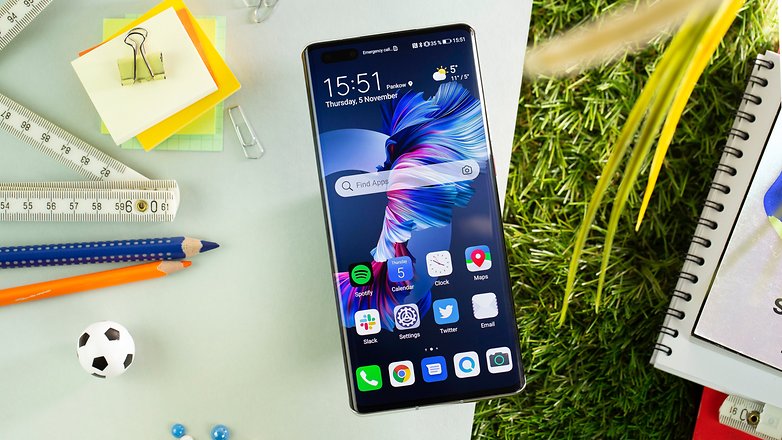
So we have curved edges on the sides, as well as on each of the four corners of the smartphone. Personally, I really like curved screens, whereas it is fashionable at the moment to hate them. I find the display much more immersive. But I admit that such design can also be a bit of a problem in terms of grip - and dropping such an expensive device is definitely not a good idea at all!
Android's gesture of swiping from the right or left edge to the centre of the screen can be temperamental at times. The occasional false touch registered on the touchscreen can also be annoying, especially when you have Knackis (a kind of sausage snack) for fingers just like me.
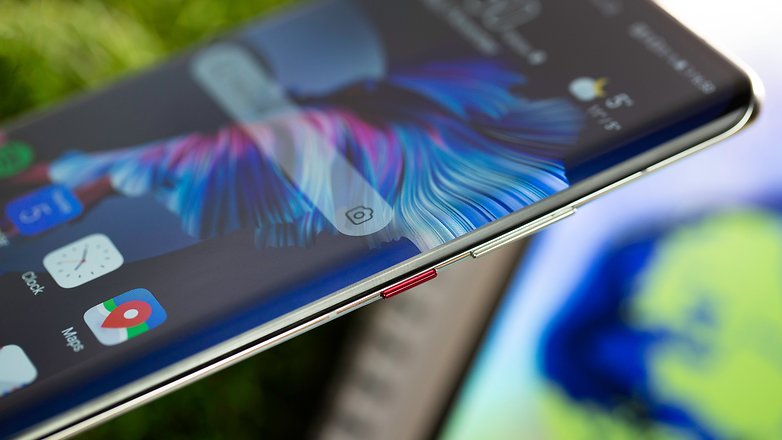
The volume rocker is placed high up on the right-hand side, which further adds to the slight ergonomic concerns that the Huawei Mate 40 Pro has to contend with. The circular photo module that is known as "Super Ring" protrudes sharply at the back, but thankfully, its placement and design does not make the smartphone unstable when it is laid flat.
In fact, I find the rear camera module placement far more original in terms of design compared to the rectangular island form factor that has been widely adopted by close to all Chinese smartphone manufacturers, making it a huge plus in my opinion.
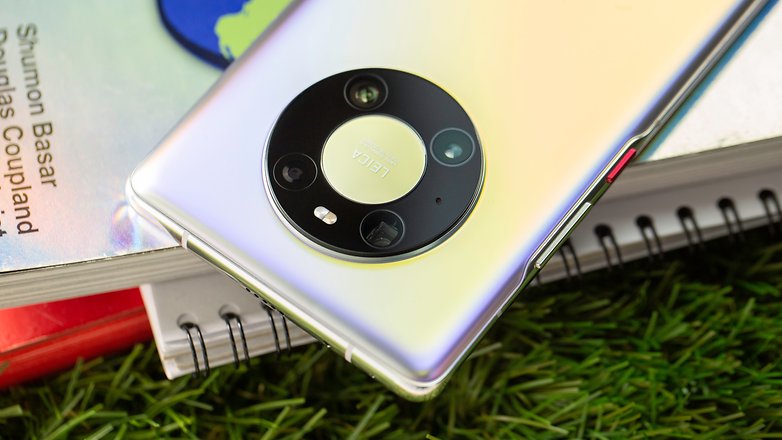
Boasting of IP68 certification, the Huawei Mate 40 Pro can accommodate two nanoSIM cards but lacks a microSD memory card slot, which means you will have to settle for the manufacturer's proprietary NM (nano memory) format if you want to expand your storage. Huawei also skips the 3.5mm audio jack and offers two stereo speakers - one located at the top while the other is at the bottom.
Overall, I find the design of the Huawei Mate 40 Pro to be visually sumptuous, which is the least I expect from a smartphone that costs a whopping £1,099. However, it's not the most ergonomic flagship handset on the market.
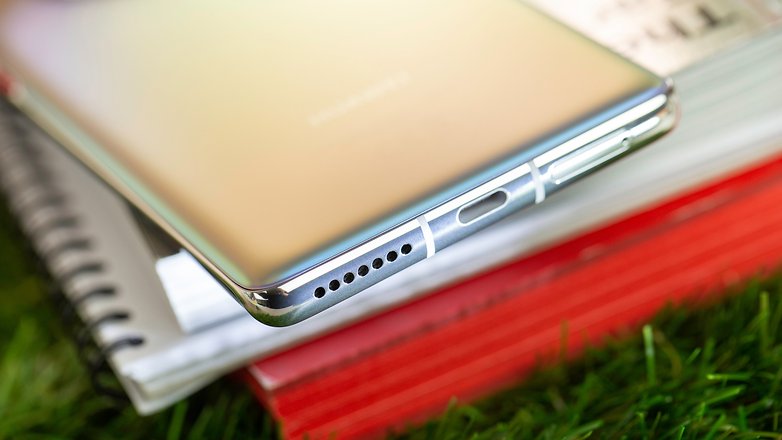
A well-calibrated 90 Hz OLED screen
The Huawei Mate 40 Pro features a 6.76-inch OLED display with an 18.5:9 aspect ratio and 90 Hz refresh rate, sporting a resolution of 1344 x 2772, or 456 dpi (pixels per inch). One can also count on HDR10 support just to make sure your visual base is thoroughly covered.
As explained above, the display has curved edges on each side but also has a slight tilt at the corners, in a cascading design that Huawei has dubbed "Waterfall Display." Apart from the few ergonomic concerns that this design choice may have caused me during the duration of my review, I found the Huawei Mate 40 Pro's display to be an amazing performer.
Please note that you can disable touch sensitivity on the curved edges for select applications, in order to avoid registering any unintended touches or simply prevent elements of the app interface from occupying the screen's curved edges.
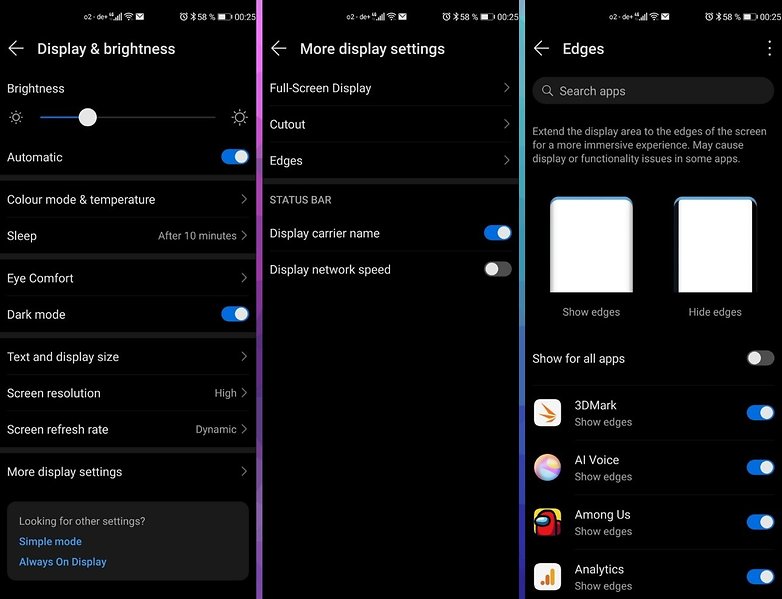
As for each of my tests, I must specify that I have no measuring tool to precisely judge the colourimetry (deta E, temperature, DCI-P3 spectrum coverage) nor the luminosity (in cd/m²). All I can say without sounding pretentious is this: the announced maximum brightness of 476 nits seems realistic, as the display has always been clearly readable and legible under all lighting conditions.
The 90 Hz refresh rate is not the highest available on the market, but it's still more than enough when we take into consideration how some flagships like the Samsung Galaxy Note 20 remain capped at 60 Hz. The display of the Huawei Mate 40 Pro is very pleasant to use when gaming.
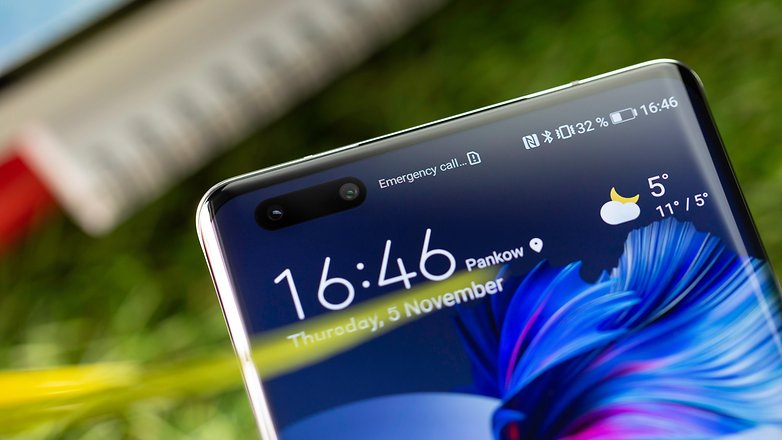
The touch sampling rate, which is the number of times the screen records a touch every second, stands at 240 Hz. This is an above-average performance that is typically found on gaming smartphones. Hence, it makes perfect sense that the touch controls on this are naturally smooth and responsive.
- Also read: Gaming smartphones: Do you need a 144 Hz screen, 16GB RAM, and the latest Snapdragon chipset?
The screen is punctured with a double-pill cutout (I've come across so many great synonyms in the comments, thank you, NextPit Community!). But the screen is so large and the edges drop off nicely that the presence of this double-pill cutout didn't get in the way of my visual immersion during use.
I am all the quicker to forgive Huawei for this shortcoming as this choice is justified by the integration of a 3D sensor in addition to the front camera to offer better facial recognition. This duo of sensors is also used in the implementation of the EOD (Eyes On Display), the special Always On Display feature from Huawei that I will talk about below.
Overall, the Huawei Mate 40 Pro's display is fantastic. It is beautiful, bright, and smooth. It ticks all of the right boxes but it doesn't have the highest refresh rate on the market.
EMUI 11 without Google: So what?
At the time of publishing, the Huawei Mate 40 Pro runs on EMUI 11, which is based on Android 10 with the September 2020 security patch. I've already dedicated a complete review of EMUI 11 on this Huawei Mate 40 Pro that I invite you to read if you want to take a deep dive into this great Android skin.
Yes, you can enjoy a Huawei interface without GMS without being a sleeper agent in Beijing and without being paid by the brand. This accusation is so ridiculous that even my banker laughed at the few readers who uttered it in my EMUI 11 review. Thank you for this moment anyway, we had a good laugh and my financier forgot, for a brief moment, the extent of my overdraft.
But I fully understand the cognitive bias that leads many users to believe that a Huawei smartphone without Google is simply unusable. Most tech journalists also take the same route to reinforce this notion in their reviews. And it is true that when the Huawei P40 was first released and I subsequently reviewed, EMUI 10 was clearly not good enough for me to recommend these flagship devices. I mentioned it at that point in time without any ambiguity.
But more than six months have passed since then. Huawei has worked hard since to improve its software suite so that EMUI 11 is now a viable option. V-I-A-B-L-E obviously doesn't to perfect. There are still some gaps to be filled but they are, in my opinion, not insurmountable when it comes to everyday use.
And this status quo has also been adopted by the press, which consists of touting the viewpoint that the P40 and Mate 40 are excellent smartphones in terms of hardware and that "if you don't mind the absence of a GMS," they may be feasible, which I find to be irrelevant.
Imagine me advising you to purchase a smartphone that costs £1,099 but does not come with a camera module in this manner: "if you are not too big on snapping photos and you are on minimum wage, then this flagship is for you." This is total nonsense. Absolute bollocks! A Huawei smartphone without GMS should either be recommended or not at all. Straddling a position in-between that most reviewers currently practice is a dangerous precedent and an especially misleading one for consumers.
Personally, I have been able to use my Huawei Mate 40 Pro on a daily basis without any major issues. Almost all the applications that I used were either available in the AppGallery, or could be installed via APK or a PWA shortcut by searching for them in Petal Search.
I was able to use these applications normally, similar to running Android with GMS:
- WhatsApp, Messenger (Facebook/Instagram), Telegram, Google Messages
- Facebook, Twitter
- Spotify, Deezer
- Google Calendar
- Gboard
I had to tinker to use the following apps, via APK or Web App:
- Google Chrome: Installed via APK, with the ability to sign in to my Google account, but without syncing my data
- Google Photos: PWA installed via a shortcut on the home screen, worked without any problems
- Google Maps: Installed via APK, worked without any problems, even when in windowed mode. However, I could not save my journeys as there was no way to connect to my Google account
- Google Drive: Installed via PWA, worked normally if you use the classic web version. Otherwise, it is impossible to add files from my Huawei smartphone
- Netflix: Installed via APK, worked fine but maxes out at SD quality (Widevine DRM is controlled by Google, Huawei smartphones can't be certified L1 for HD, we are blocked at level L3)
- YouTube: Installed via PWA shortcut (web version), possible to connect to your Google account, HD quality available
- Slack: Installed via APK, worked without problems but without push notifications (which has to go through Google Play).
- Gmail: A Web app exists but I preferred to go through the native mail application of Huawei, which allows me to add a Gmail account
- Google Meet: Installed via a Web app shortcut, without the ability to join a meeting by clicking on a link via Google Calendar or Slack (you must manually enter the code of each meeting)
- Zoom: Installed via APK, worked without any problem with the possibility to connect via my Google account
- Call of Duty Mobile: Installed via APK, connected via Facebook, worked without problems
- Jabra Sound+: A companion application for my true wireless Jabra Elite 85t headphones, downloaded via APK and worked without a hitch, even with Huawei's Celia voice assistant
In any case, I plan to do a 100-day test with EMUI 11 without Google. So I will keep the Huawei Mate 40 Pro as my daily driver until then. But after spending one month (since October 22nd, 2020) with it, I can say without any hesitation that Huawei smartphones under EMUI 11 are far - very far indeed, from being unusable. So I would totally inform you that they are recommended for purchase.
As for the rest, EMUI 11 is a fairly incremental update of the Huawei interface. Notable additions include a special Always On Display known as EOD or Eyes On Display, as well as an improved multitasking mode.
Huawei's EOD or Eyes On Display
Let's start with Eyes On Display. Concretely, it is Huawei's version of the classic AOD, sporting an animation and essential information such as time, battery level, etc.
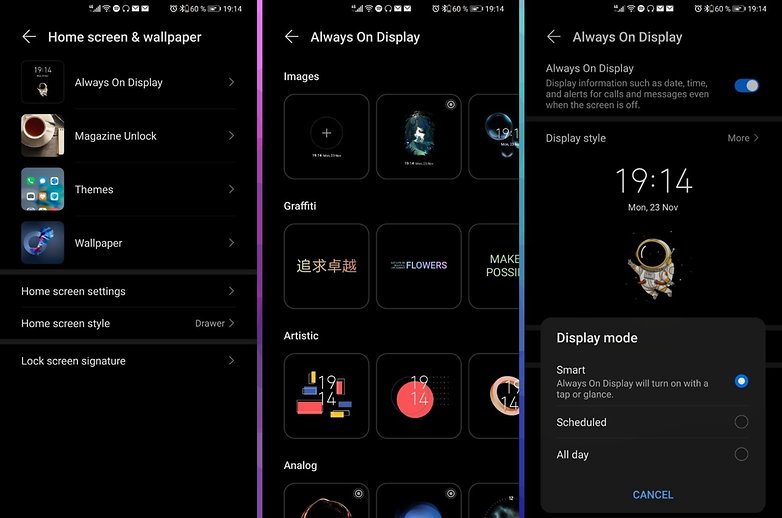
Thanks to the dual front camera module which includes a 3D sensor, the Huawei Mate 40 Pro is able to detect your face whenever it faces the screen. It basically works the same way as Google's Face Unlock. The smartphone only activates the AOD when you're looking at the screen in order to preserve battery life.
It works pretty well, too. I tried to cheat by placing my big head in front of the screen but with my eyes closed and the smartphone didn't react. It's a pretty subtle twist to a feature that's no longer very innovative but makes it more interesting, a bit like the Insight AOD from OnePlus.
The 3D/ToF sensor on the front photo module also enables facial recognition in the dark, and makes unlocking more secure, similar to Apple's Face ID. In fact, unlocking is much faster than using the fingerprint reader located beneath the screen.
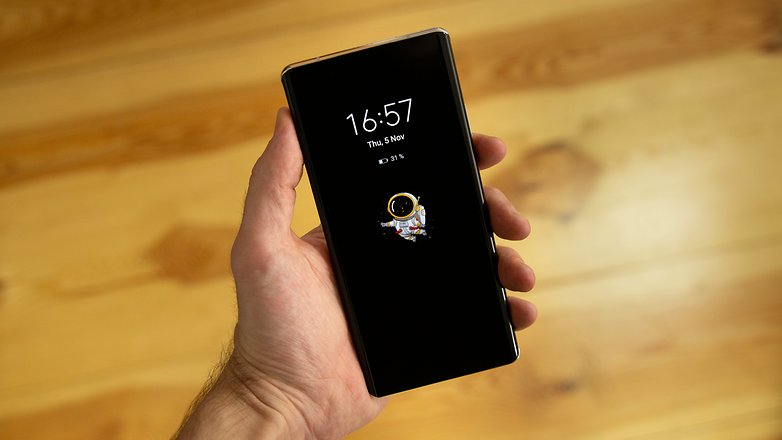
Huawei's windowed mode delivers multitasking
This is the second big news about EMUI 11 on the Huawei Mate 40 Pro, which mainly caters to power users. You can add some applications to be opened in windowed mode via the sidebar that is easily accessible with a simple extended swipe.
You can then display an application in a floating window and adjust its size and position on the screen as you wish. You also have the ability to display two applications in a split-screen format, or minimise a windowed app that will remain on the screen as a bubble widget if you ever want to reopen it.
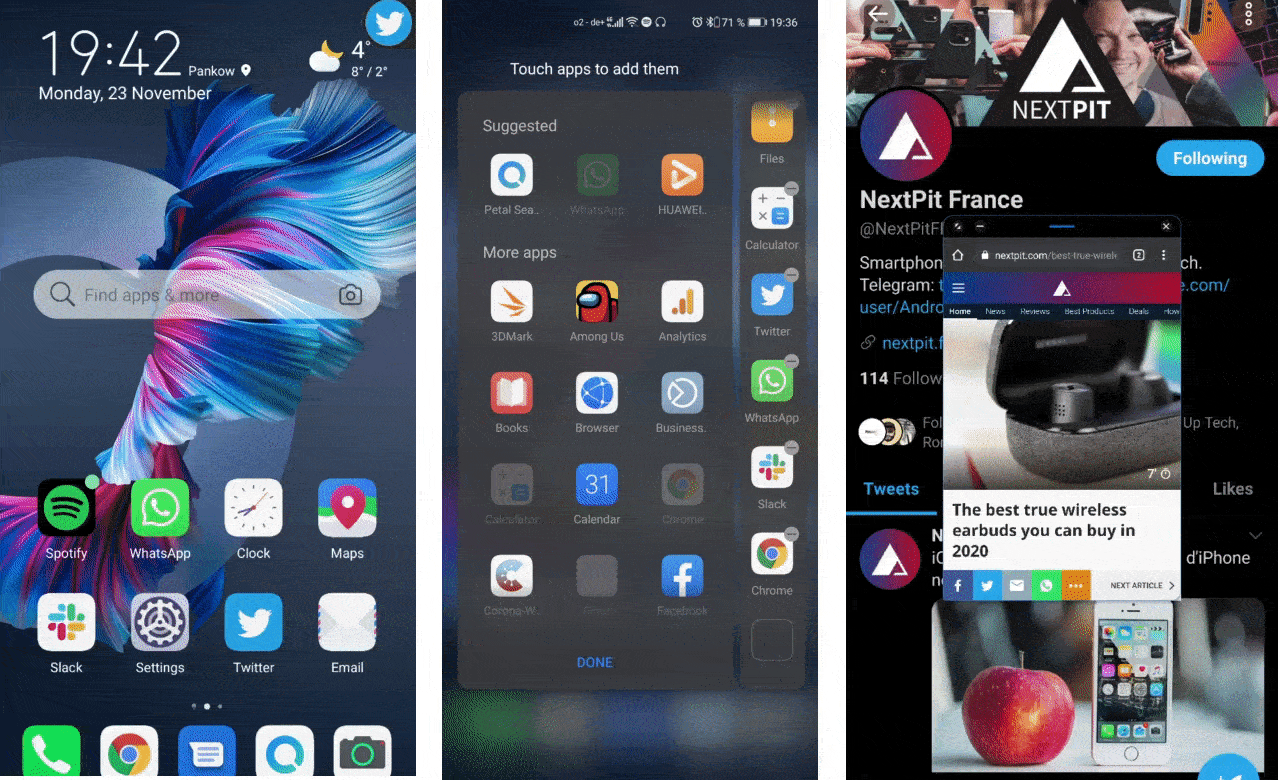
The whole thing is quite intuitive and, if your usage requires it, it can be practical for multi-tasking. I have not noticed any lags or animation issues throughout my experience. But there is a far more advanced implementation of this idea from Samsung's OneUI, for instance.
Petal Search and Quick Apps fill the Google gap
Petal Search was launched at the end of October by Huawei. It is a search engine both for the web and for apps.
And given its usefulness, Petal Search has clearly supplanted the AppGallery for me. If I'm looking for an app, I go directly to Petal Search. The tool then tells me if the app in question is available via the AppGallery directly, or as an APK, or if I need to create a web shortcut in "web app" mode.
We're familiar with the status quo. Most applications that are not available on the AppGallery can be downloaded from Petal Search via APK. For Google applications, like Gmail, you can create a browser shortcut to the mobile web version.
Personally, I'm not a fan of this solution. Take Gmail, for example. I can create a web shortcut that will be displayed as a widget on my home screen, like a "normal" app, but each time I open the app/ shortcut, it will open a new page in my browser. It's not very ergonomic and neither is it efficient.
To remedy this, Huawei allows you to create "Quick Apps." Concretely, when an application is available as a PWA (progressive web app), you can create a shortcut on your home screen. So it's not just a widget that acts to redirect you to a new tab in your browser in order to access the mobile web version of an app. It's really a PWA with an interface that is suitable for mobile use, which is separate from the browser experience.
Unfortunately, not all apps are supported at this moment. I've been able to use it for Google Drive, Google Meet, and YouTube, among others though.
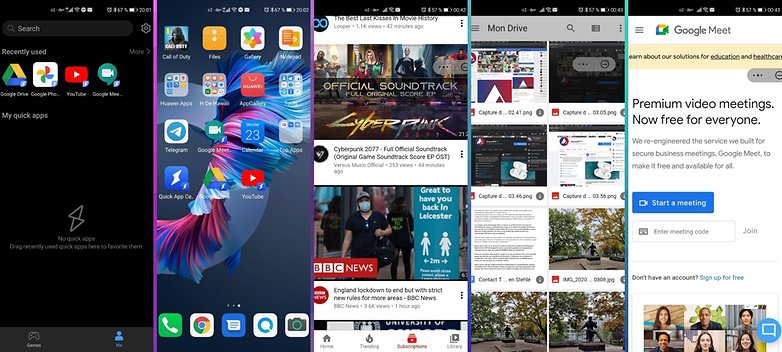
The other little extra in EMUI 11 is that Petal Search now offers you to create these shortcuts directly, without you having to do it yourself via your browser settings.
Another very good addition to Petal Search is the ability to receive automatic notifications as soon as an APK update is available. As you would probably know, an APK is a "static" version of an app and therefore, on a Huawei smartphone, they are not automatically updated via the Play Store since the Play Store is absent in the first place.
So this is a very good step forward for Huawei, as you can be notified as soon as an update is available. This allows you to stay on top of the security updates on the software side.

As for the rest, I invite you to read my EMUI 11 review to prevent this section from spilling over into the rest of the smartphone's review. I will, however, mention the addition of a new "Today" menu to replace your Google Feed when you swipe to the far left of the home screen.
You can also choose to display your apps in an app drawer, and all the other native Android features are present like screen recorder, dark mode, eye comfort, etc.
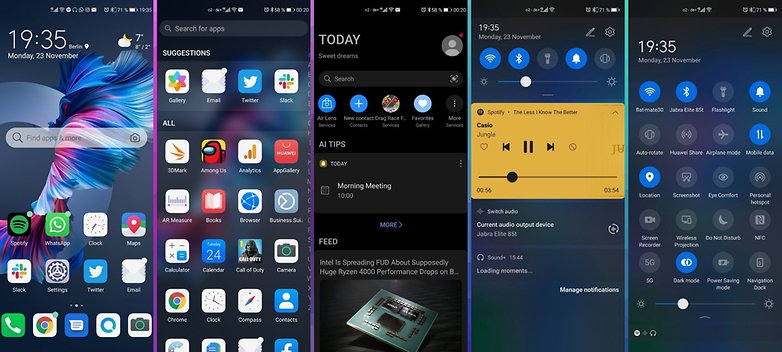
In short, as I explained at length, EMUI 11 is not a 100% complete alternative to Android or GMS. But sincerely, I invite all my critics to test it out for themselves to realise that, except for certain specific cases, Huawei's smartphones are quite usable under such conditions. We're far from having a user interface that is totally handicapped by the absence of GMS.
However, I can't comment on the issue of managing your connected home ecosystem running Google Home or connected devices. Celia, Huawei's voice assistant is certainly not supported by most of the devices that you already own. Alexa is on the list of apps waiting for availability in the AppGallery. You are also unable to install Google Assistant.
And one should also remember that Huawei will not be able to continue to base its interface on Android 10 as well as subsequent versions of Android. The switch to HarmonyOS is compulsory and not an option. Considering what the manufacturer is proposing with EMUI 11, I'm more than optimistic about the future of its software suite when the post-Google era begins for good.
The power of Kirin 9000
The Huawei Mate 40 Pro runs on the latest home-grown, high-end chipset: Kirin 9000. The 5nm octa-core CPU has one Cortex-A77 core clocked at 3.13 GHz, 3 Cortex-A77 cores clocked at 2.54 GHz and 4 Cortex-A55 cores clocked at 2.05 GHz. It is mated to a Mali-G78 GPU.
This is the most complicated part of this review. And for good reason, too, as I was only able to install one graphics benchmark on the Huawei Mate 40 Pro, namely 3DMark. The other benchmarks are not yet available on the AppGallery and it was impossible for me to make them work, or even simply launch them, after downloading them via APK.
I could read in the review by XDA Developer that Huawei would have blocked the installation of benchmarks and that we would have to wait for one that actually bypasses such blocks. However, I also noticed that GSMArena published benchmark scores in its test from Geekbench 5, which personally, I could not install.
I will therefore essentially rely on the results from 3DMark, which nevertheless offers a fairly complete set of benchmarks. And the most notable feature of this Huawei Mate 40 Pro is the difference in the performance of the Kirin 9000 in normal mode and in "Performance" mode.
Like many high-end smartphones, the Mate 40 Pro offers a performance-boosting mode, primarily for games. Generally, the performance differences are quite small. On the Huawei Mate 40 Pro, it is as stark as day and night.
By default, under normal mode, the smartphone is not really impressive against competitors equipped with the Snapdragon 865 or 865+ chipset the Asus ROG Phone 3, the Nubia RedMagic5S, or the OnePlus 8 Pro. We're right at the top of the hill, but it's nothing jaw-dropping.
Once the "Performance" mode is activated, you'll reach scores that far exceed the most powerful gaming smartphones on the market. That's pretty impressive on paper. However, there is a catch.
Huawei Mate 40 Pro Benchmark Comparison (Performance Mode: Off)
| Huawei Mate 40 Pro | RedMagic 5S | Asus ROG Phone 3 | OnePlus 8 Pro | |
|---|---|---|---|---|
| 3D Mark Sling Shot Extreme ES 3.1 | 6317 | 7736 | 7724 | 7122 |
| 3D Mark Sling Shot Vulkan | 4953 | 7052 | 7079 | 6613 |
| 3D Mark Sling Shot ES 3.0 | 7677 | 9687 | 9833 | 8864 |
| Geekbench 5 (Single / Multi) | Untested | 902/3232 | 977 / 3324 | 887/ 3313 |
| PassMark Memory | Untested | 27.442 | 28.568 | 27.118 |
| PassMark Disc | Untested | 88.322 | 124.077 | 50.083 |
Huawei Mate 40 Pro Benchmark Comparison (Performance Mode: On)
| Huawei Mate 40 Pro | RedMagic 5S | Asus ROG Phone 3 | OnePlus 8 Pro | |
|---|---|---|---|---|
| 3D Mark Sling Shot Extreme ES 3.1 | 8093 | 7736 | 7724 | 7122 |
| 3D Mark Sling Shot Vulkan | 5217 | 7052 | 7079 | 6613 |
| 3D Mark Sling Shot ES 3.0 | 9920 | 9687 | 9833 | 8864 |
| Geekbench 5 (Single / Multi) | Untested | 902/3232 | 977 / 3324 | 887/ 3313 |
| PassMark Memory | Untested | 27.442 | 28.568 | 27.118 |
| PassMark Disc | Untested | 88.322 | 124.077 | 50.083 |
The problem is overheating, or rather temperature control that is activated by the Huawei Mate 40 Pro. I don't have precise tools to measure this in my tests, but recently, the 3DMark benchmark offers a test known as "Wild Life". This test simulates, over 1 and 20 minutes, an intense game session with graphical settings pushed to the maximum. The idea is to see how the smartphone behaves once it is pushed to its limits.
This benchmark then informs us of the temperature variation, the FPS rate, and battery consumption rate. Temperatures will always rise, it's an inevitable law of physics. But the more the FPS fluctuates as the temperature rises, the more you are able to measure the thermal throttling that kicks in.
I talk about the idea of throttling in my best gaming smartphones guide. In concrete terms, it's about limiting the performance of the smartphone in order to prevent it from overheating. And the Huawei Mate 40 Pro is very quick to activate throttling in order to remain as cool as possible.

In this example above, we can see that the Huawei Mate 40 Pro has heated significantly less than the Asus ROG Phone 3, maintaining the maximum temperature at 33°C versus 40°C for the ROG Phone 3. But it can be noted that the framerate is far more inconsistent than on the Asus smartphone.
Just compare the two graphs on the far left of the image above: the difference between the first loop (1 minute) and the vineme loop (20 minutes) is obvious on the Mate 40 Pro. The ROG Phone 3 maintains a very similar level of performance.
This is where we can see one of the impacts of thermal throttling. In order to prevent overheating, the Mate 40 Pro limits performance, while the ROG Phone 3, equipped with a better cooling system, can afford to run at higher temperatures for a longer period of time without having to sacrifice on performance.
But that's really a technical detail that most users don't care about. This handset remains a top performer in flagship Android smartphone territory. However, the lead that the Huawei Mate 40 Pro has in its performance mode is not a huge one, either. And with the upcoming release of the Snapdragon 875 chipset, this record-breaking Huawei processor will not occupy its place at the top of the hill for long.
The best camera module on the market
The Huawei Mate 40 Pro has a triple camera module at the back that is very similar to the Huawei P40 Pro with:
- 50 MP wide-angle main sensor, f/1.9 aperture, 28 mm equivalent, OIS, RYYB
- a 12 MP periscopic telephoto lens, f/3.4 aperture, 125 mm equivalent, OIS
- 20 MP ultra-wide-angle sensor, f/1.8 aperture, 18 mm equivalent
The camera module is arranged in a circular pattern in a design that Huawei has dubbed Super Ring. The ultra-wide-angle sensor also comes with a special lens system that is known as "free form lens". In practical terms, Huawei is trading the spherical design of conventional optics for an asymmetrical lens design with an irregular surface.
The idea behind this choice is the result of more than two years of development. It is meant to limit as much distortion as possible found inherently in ultra-wide-angle photos, which gives them that rather strange "fish-eye" effect. Apart from this new feature, we are completely blown away by the excellent standards set by the Huawei P40 Pro.
Pictures of the Huawei Mate 40 Pro by day
Unsurprisingly, the Huawei Mate 40 Pro does extremely well in daylight. I had a hard time freeing up an afternoon for a sufficiently comprehensive photoshoot. And I had even more trouble getting good lighting conditions because of the Berlin climate.
But I was really convinced by the Huawei Mate 40 Pro and its triple sensor system. I will talk about the zoom in detail below, but the biggest achievement of this camera module, apart from the zoom, is its dynamic range management.
The series of photos below was taken on a mid-November afternoon, from 2:00 to 3:00 pm. The sun is already almost setting. I was surprised to prefer the photos taken with the ultra-wide-angle sensor compared to those taken with the wide-angle sensor.

The level of detail is surprisingly good in ultra-wide mode, and I find the picture brighter. But if you look at the wide-angle shots that are certainly darker, you can see that the level of detail is very good. Sharpness is present, the image is clear and noise is almost totally absent. Even the most shaded areas remain well defined and as legible as the brightest areas.
I find the rendering to be particularly natural, even if the white balance leans very subtly more towards warm, yellow tones. One obtains warm, soft clichés, which do not attack the retina with artificially bright colours. Only iPhones offer such a natural rendering, albeit without the level of detail.
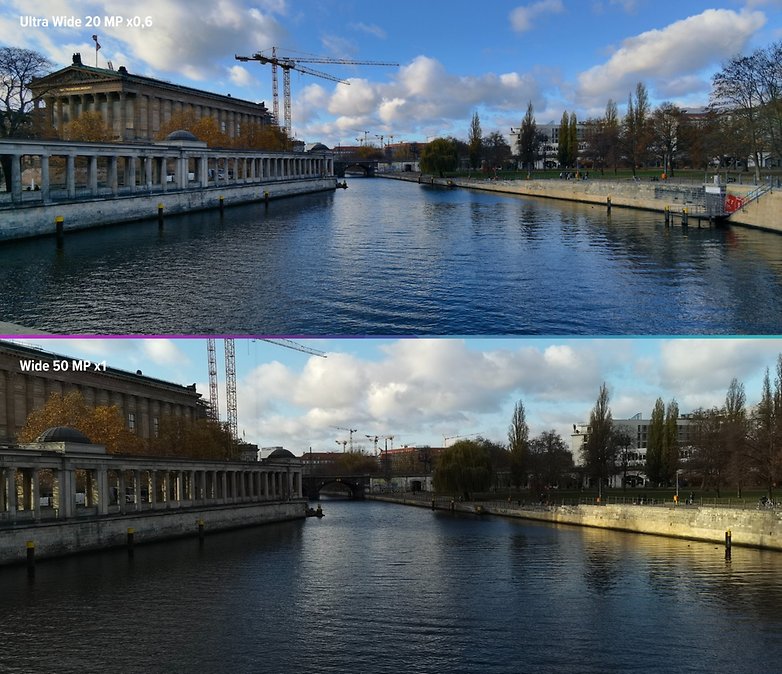
We also have the possibility to dispense with pixel binning and take wide-angle shots in full 50 MP resolution. But I found the difference in terms of detail too small to be illustrated by a picture in this review.
The dual combination of wide-angle and ultra-wide-angle sensors is therefore extremely impressive, and happen to be among the best I tested this year. And the Huawei Mate 40 Pro is surely the only photo smartphone whose ultra-wide-angle shots may look "nicer" than those captured with the main sensor. Surely, a tour de force from the manufacturer!
Huawei Mate 40 Pro zoom photos
Huawei's major strength for several years has been its ability to offer the most powerful optical zoom on the market, there is no doubt about that. On most of today's flagships, the fancy 10x, 30x, 50x, or 100x zoom magnification is often unusable. This is clearly not the case on the Mate 40 Pro.

In practice, up to the 10x zoom level, the loss of detail is almost imperceptible. Perhaps it's the contrast with the inferior performance of its competitors that exaggerated my opinion. But I sincerely had the impression that the zoom maintains a more than usable, even very good, rendering, whether in 2x, 5x, or 10x.
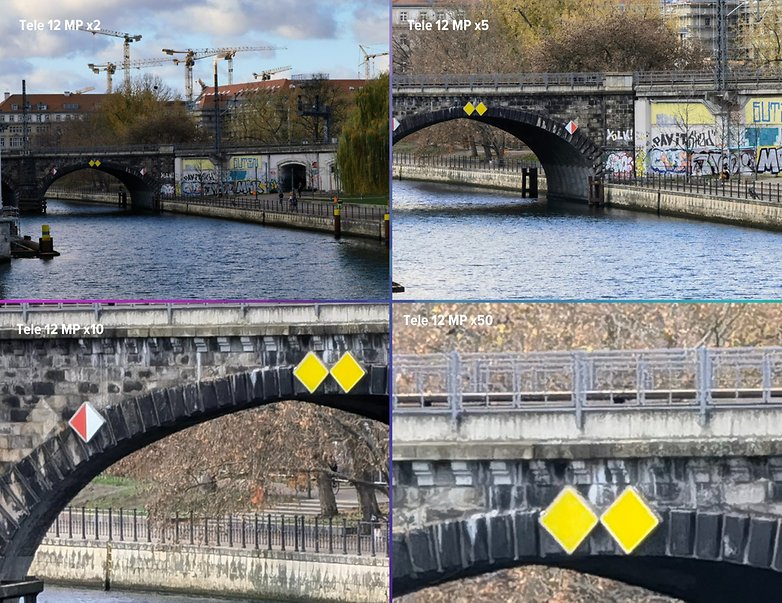
Logically, one can note the digital noise and the nosediving detail loss in 50x. But this is generally the level of quality you get in 10x zoom on other models such as the Samsung, Apple, Oppo flagships, and even in Google's seemingly sacrosanct Pixels.
The optical stabilisation on the Mate 40 Pro's telephoto lens plays a key role in this performance. Try it with an OIS-free smartphone, you'll have a hard time taking pictures beyond the 5x zoom freehand without any motion blur occurring.
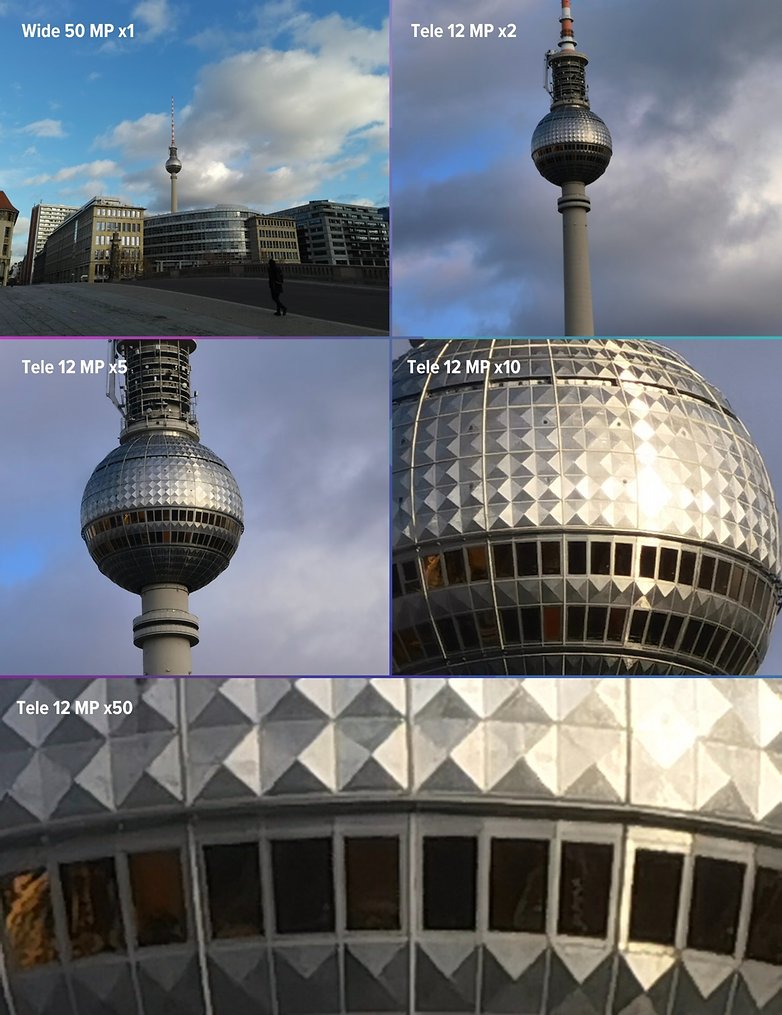
I know I sound like a fanboy or a corrupted journalist who received a big fat check, but I was simply blown away every time I zoomed in on one of my pictures. Without any tripod, lack of photography skills, and not using the Pro mode, I find it rather exceptional that a smartphone offers such amazing shots by default.
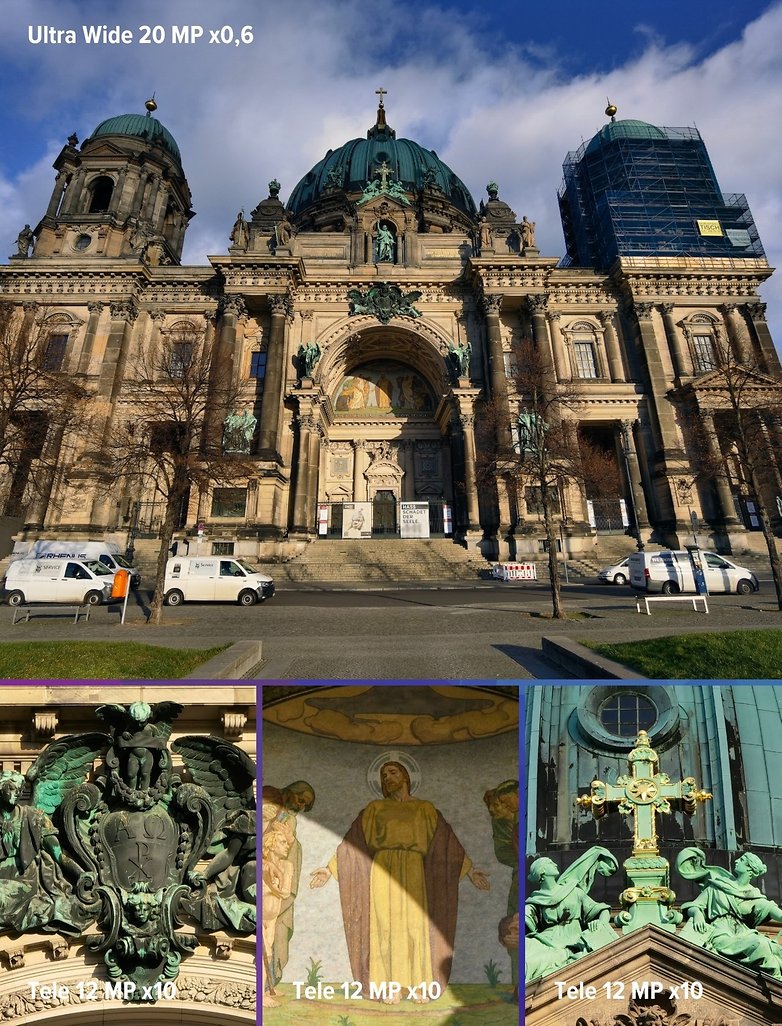
I think that's the big strength of this camera module. The telephoto lens offers so many possibilities, it makes the Mate 40 Pro extremely versatile in hunting down new shots. I don't think any other manufacturer can currently compete with Huawei on this particular point - zoom.
Photos of the Huawei Mate 40 Pro at night
Huawei's cameras on its smartphones are also known to offer very good night shots. Personally, I have always preferred more natural renderings, which do not give the impression that the photo was taken in broad daylight. I found the dedicated night mode of the P30/P30 Pro to be too pronounced.
On the Huawei Mate 40 Pro, I had a hard time differentiating between night shots taken with and without night mode. I don't know if it's because the night mode is much less aggressive, or if it's because the 50 MP main sensor with its RYYB filter also captures a lot of night light, even without night mode.
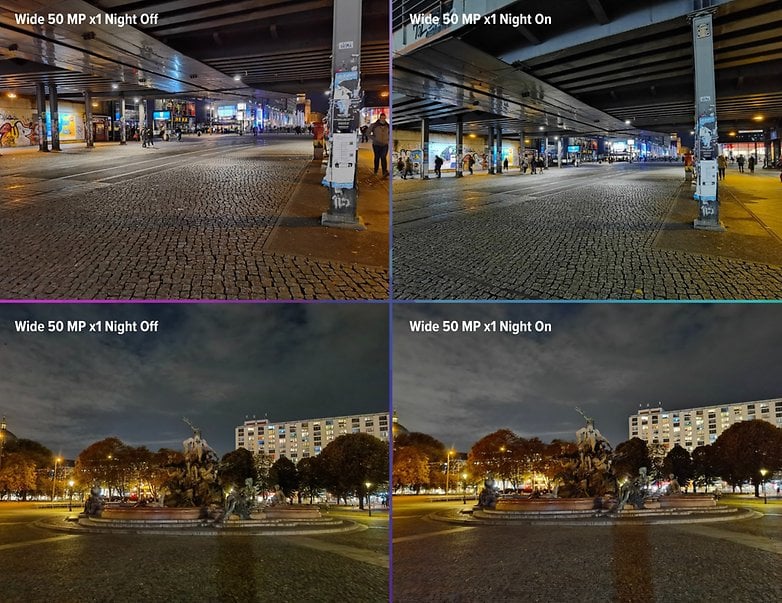
But if you look closely at the photos illustrated above, you can notice a correction in the exposure and white balance, which becomes slightly cooler, so as to remove this yellowing effect of night lighting. If you look at the pavement on the ground (zoom in on your screen), you may also notice that the digital noise is reduced and the sharpness is more pronounced. You can notice the gaps between the individual paving stones more clearly.
The impact of night mode is perhaps most noticeable in the photos below. We can see that the sky is slightly clearer, bluer than black compared to the shot captured without night mode. The exposure has also been corrected by limiting the amount of light emitted by the street lamps, which burn the image a little too much when taken without night mode.
Take a look at the building in the photo of Alexander Platz (below, from left to right). It is almost red, just like the sky because of the urban lighting. With the night mode, these problems are reduced and the picture looks cleaner, colder.
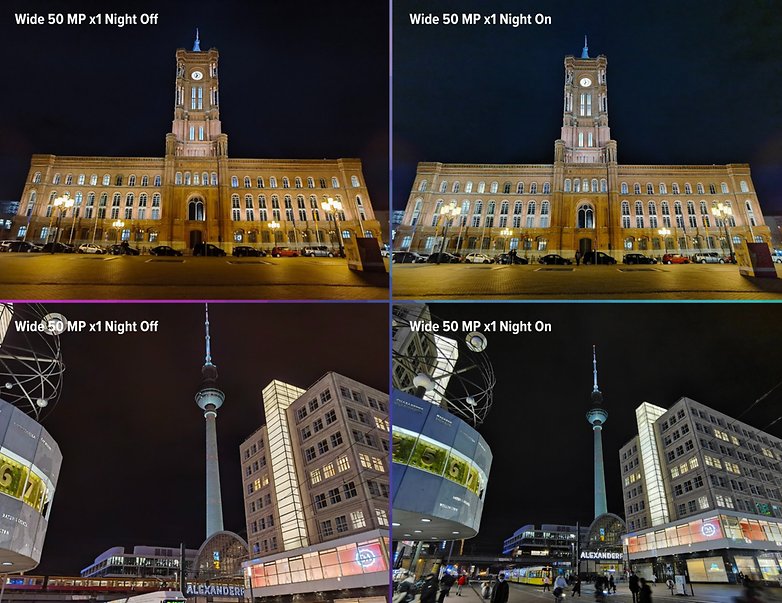
Overall, the Huawei Mate 40 Pro offers a very good camera package, and in my opinion, is the best on the market. I love the versatility of the camera module that is offered by the excellent telephoto lens and the very good night mode, I love the quality of the ultra-wide-angle and I find the software processing to be subtle and natural (or rather realistic).
Solid battery life
The Huawei Mate 40 Pro has a 4,400 mAh battery with good battery life. With the screen set up to follow a dynamic refresh rate, varying between 60 Hz and 90 Hz depending on usage (games, user interface navigation), the smartphone last for more than 17 hours before going under the 20% mark of remaining battery life.
Unfortunately, I was also unable to install the PCMark benchmark that we use at NextPit to push the battery to its extremes. So I'm clearly basing my opinion based on my daily use of the smartphone, with an average of 6 hours of screen time per day devoted to mobile gaming, video conference calls, and music streaming during the majority of my time at the office.
In practical terms, the smartphone is able to last for just over two days of use. This is a very good result. I find the battery utility quite complete. It doesn't allow you to view your previous usage history for the last 24 hours, which is a shame for reviewers like me who would like to capture screenshots after a week of use.
But we do have the full range of battery life optimisation available with a power-saving mode, and we also have an adaptive charger that takes into account your usage pattern which will pause or slow down the charging process when you're not using the smartphone while making sure it's at 100% when you turn it on when you wake up.
The Huawei Mate 40 Pro also comes with a 66-watt SuperCharge charger that provides up to 100% battery life in less than 50 minutes. Out of the three tests that I took the time to time (this is the most boring part of a review), it took 47, 48, and 47 minutes respectively to go from 0 to 100. The Huawei Mate 40 Pro also offers 50-watt wireless charge and a 5-watt reverse wireless charge support.
Conclusion
As you can see, I'm not going to juggle with uncertainty, "maybes", "ifs" and other rhetorical terms to tell you that the Huawei Mate 40 Pro is an excellent high-end smartphone in more ways than one. But it really is a shame that it doesn't include Google's Mobile Services.
But I have enough hindsight to spare my different subjectivities from surfacing and tell you that the Huawei Mate 40 Pro is a great smartphone except for...well, nothing.
The absence of Google services is still being felt, of course. But to say that EMUI 11 without GMS is unusable is a totally false premise. I find that Huawei's efforts on its software suite promising, and I do not regret using the Mate 40 Pro on a daily basis for the past month. You'll know in a few months if my opinion will change over time or not.
The camera module far exceeds what the competition offers, and I was particularly convinced by the possibilities available via the telephoto lens as well as the subtle efficiency of the night mode. The Kirin 9000 is a monster of a chipset, but I question the longevity of its performance in the face of Qualcomm's competition, which will soon see a new release in 2021.
Battery life is solid without reaching the heights achieved by industry leaders such as Xiaomi, for example. The screen is very well calibrated and smooth even if it is considered as average in the market at this price range. The design is unquestionably sumptuous and worthy of the very high price tag of this ultra-premium smartphone.
It is thus clearly not a checkmate but rather a rook that this Huawei Mate 40 Pro is, shielding its king from danger.
Also read on NextPit:
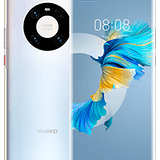









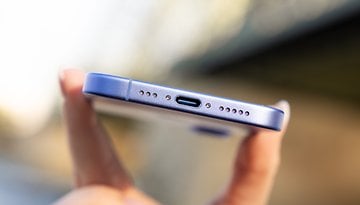
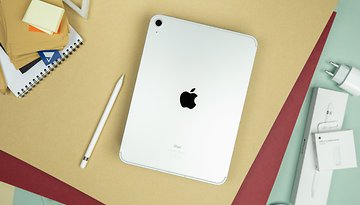
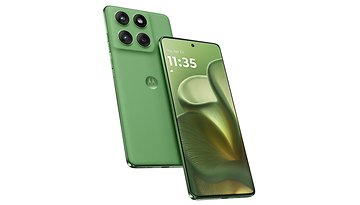
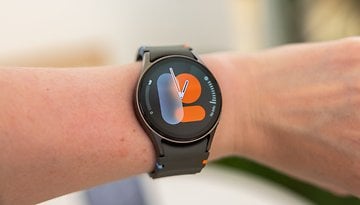

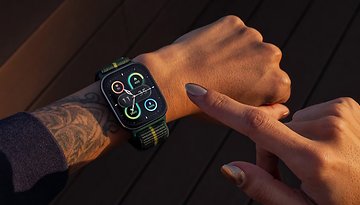




It`s a very good phone!
I had three Huawei phones. Mate 2, 8,9
Loved them, great phones, never had an issue until they started locking the bootloader, then the ban in the USA, can't get any support or updates without rooting. With all the backdoors/data mining etc...screw em.
An impressive phone from all points of view, very good performance, still high price, but here too it is a big "butt", but it can no longer use Android. For those who are used to Android, switching to another operating system, even if similar, this switch will not be to their liking.
Personally, I have a P20 Pro that I am very happy with, especially on the photo side, I really liked Huawei's innovations, only that in the current situation, due to the impossibility of being able to use Android, I have to choose the next mobile phone. either ... Xiaomi, it's more to my taste. I say it strictly personally. Because today's phones have reached exceptional performance, which makes choosing a phone quite difficult.
Way overpriced considering the crap skin and bloat, the bad update schedule, the google kluge, the documented security backdoors of Huawei, kirin weakness.
No this is a last gasp demonstrating their true weakness.
Wow someone is throwing their toys out the pram, & a major over reaction